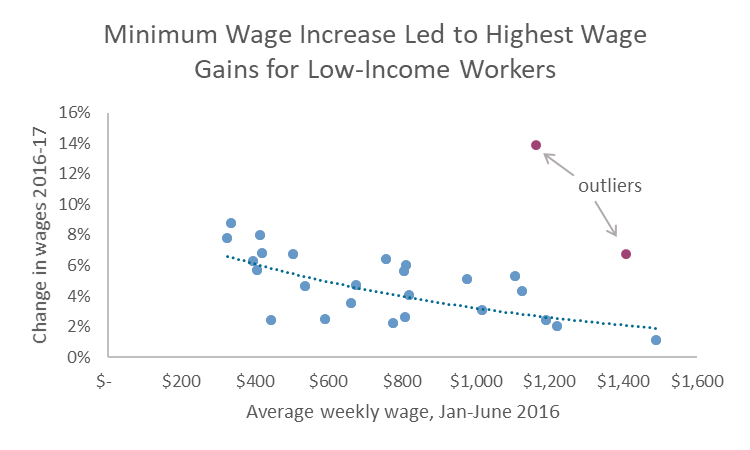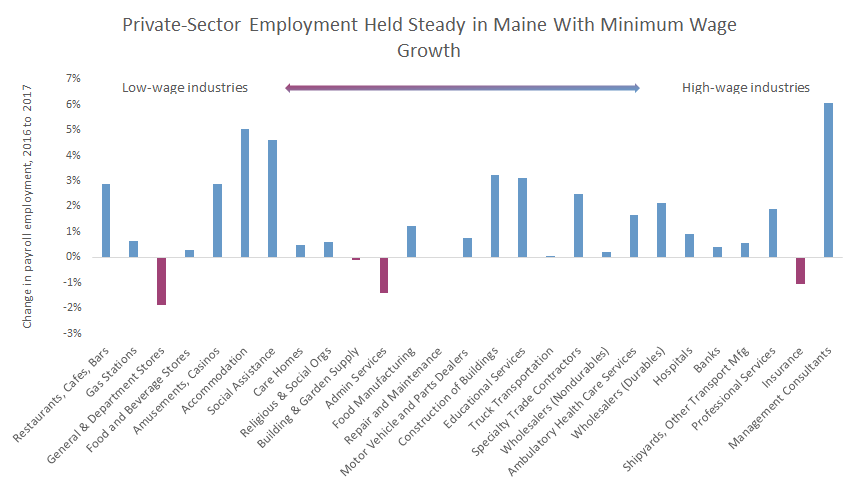Wage and employment gains during the first six months of 2017 reveal that Maine’s voter-approved minimum wage increase has not hurt the state’s economy as the referendum’s opponents warned it would. Instead, one year after the first minimum wage increase went into effect, available data suggest that the initiative is working as intended by helping to increase wages with no apparent adverse impact on employment.
According to MECEP analysis of data from the U.S. Bureau of Labor Statistics, total wages in Maine grew by $587 million in the first half of 2017 compared with the first half of 2016. That’s a 4.7 percent year-over-year increase, the largest such increase since before the Great Recession.
Wage and job growth in the first half of 2017 coincided with the first minimum increase in eight years, which raised Maine’s wage floor from $7.50 to $9 per hour starting on January 7, 2017. The tipped minimum wage also increased from $3.75 to $5.00 per hour. As expected, data from the state’s largest employment sectors indicate that workers in the lowest-paid industries experienced the biggest proportional wage gains. That’s because low wage workers benefitted most directly from the higher minimum wage.
Source: MECEP analysis of US Bureau of Labor Statistics, Quarterly Census of Employment and Wages, 2016-17 data. Private-sector payroll employees. Results for 2017 are preliminary. Each data point represents a major industrial employment sector. The outliers represent “insurance carriers” and “credit intermediation” employers, whose wage gains are likely increased by a greater reliance on shares and bonuses as compensation.
Job growth continues
While wages increased, there is no evidence that the minimum wage increase led to a significant decline in jobs. Statewide, employment continued its upward climb, with an additional 8,000 Mainers finding jobs between January and June of 2017, according to Maine Department of Labor data.
Employment increased in nearly every industry, including the lowest-wage industries, where job losses were predicted by opponents of the minimum wage.
Source: MECEP analysis of US Bureau of Labor Statistics, Quarterly Census of Employment and Wages, 2016-17 data. Private-sector payroll employees. Results for 2017 are preliminary.
Wage and employment gains achieved statewide
Average wages increased in every county in Maine between January and July 2017 compared to the first half of 2016. Three areas – Midcoast Maine, Kennebec and Penobscot counties – experienced wage increases above the statewide average.
Similarly, employment improved or held steady in every county over the same time period with the exception of Sagadahoc and Somerset counties. However, both cases can be explained by manufacturing layoffs. Bath Iron Works laid off workers and the Madison Paper Mill closed in 2016. Neither BIW nor the paper mill attributed the job losses to the forthcoming minimum wage increase.
Conclusion
In short, none of the doomsday predictions from opponents of Maine’s minimum wage increase were borne out. While it is difficult to isolate the effect of the minimum wage increase on jobs or wages by itself especially since the US economy continues to grow, the fact remains that Maine’s voter-approved minimum wage increase coincides with one of the largest real-term gains in private-sector wages in fifteen years, and provided clear benefits for low-income workers. That’s a win for Maine’s workers and economy.





